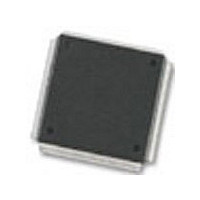MC68376BAMFT20 Freescale Semiconductor, MC68376BAMFT20 Datasheet - Page 101

MC68376BAMFT20
Manufacturer Part Number
MC68376BAMFT20
Description
Manufacturer
Freescale Semiconductor
Datasheet
1.MC68376BAMFT20.pdf
(434 pages)
Specifications of MC68376BAMFT20
Cpu Family
68K/M683xx
Device Core
ColdFire
Device Core Size
32b
Frequency (max)
20MHz
Interface Type
QSPI/SCI
Program Memory Type
ROM
Program Memory Size
8KB
Total Internal Ram Size
7.5KB
# I/os (max)
18
Number Of Timers - General Purpose
2
Operating Supply Voltage (typ)
5V
Operating Supply Voltage (max)
5.25V
Operating Supply Voltage (min)
4.75V
On-chip Adc
16-chx10-bit
Instruction Set Architecture
RISC
Operating Temp Range
-40C to 125C
Operating Temperature Classification
Automotive
Mounting
Surface Mount
Pin Count
160
Package Type
PQFP
Lead Free Status / Rohs Status
Not Compliant
Available stocks
Company
Part Number
Manufacturer
Quantity
Price
Company:
Part Number:
MC68376BAMFT20
Manufacturer:
FREESCAL
Quantity:
245
- Current page: 101 of 434
- Download datasheet (7Mb)
5.5.1.8 Data and Size Acknowledge Signals
5.5.1.9 Bus Error Signal
5.5.1.10 Halt Signal
MC68336/376
USER’S MANUAL
The supervisor bit in the status register determines whether the CPU is operating in
supervisor or user mode. Addressing mode and the instruction being executed deter-
mine whether a memory access is to program or data space.
During normal bus transfers, external devices assert the data and size acknowledge
signals (DSACK[1:0]) to indicate port width to the MCU. During a read cycle, these sig-
nals tell the MCU to terminate the bus cycle and to latch data. During a write cycle, the
signals indicate that an external device has successfully stored data and that the cycle
can terminate. DSACK[1:0] can also be supplied internally by chip-select logic. Refer
to 5.9 Chip-Selects for more information.
The bus error signal (BERR) is asserted when a bus cycle is not properly terminated
by DSACK or AVEC assertion. It can also be asserted in conjunction with DSACK to
indicate a bus error condition, provided it meets the appropriate timing requirements.
Refer to 5.6.5 Bus Exception Control Cycles for more information.
The internal bus monitor can generate the BERR signal for internal-to-internal and
internal-to-external transfers. In systems with an external bus master, the SIM bus
monitor must be disabled and external logic must be provided to drive the BERR pin,
because the internal BERR monitor has no information about transfers initiated by an
external bus master. Refer to 5.6.6 External Bus Arbitration for more information.
The halt signal (HALT) can be asserted by an external device for debugging purposes
to cause single bus cycle operation or (in combination with BERR) a retry of a bus cy-
cle in error. The HALT signal affects external bus cycles only. As a result, a program
not requiring use of the external bus may continue executing, unaffected by the HALT
signal.
FC2
0
0
0
0
1
1
1
1
Table 5-10 Address Space Encoding
SYSTEM INTEGRATION MODULE
FC1
0
0
1
1
0
0
1
1
FC0
0
1
0
1
0
1
0
1
Supervisor program space
Supervisor data space
User program space
User data space
Address Space
CPU space
Reserved
Reserved
Reserved
MOTOROLA
5-23
Related parts for MC68376BAMFT20
Image
Part Number
Description
Manufacturer
Datasheet
Request
R
Part Number:
Description:
Manufacturer:
Freescale Semiconductor, Inc
Datasheet:
Part Number:
Description:
Manufacturer:
Freescale Semiconductor, Inc
Datasheet:
Part Number:
Description:
Manufacturer:
Freescale Semiconductor, Inc
Datasheet:
Part Number:
Description:
Manufacturer:
Freescale Semiconductor, Inc
Datasheet:
Part Number:
Description:
Manufacturer:
Freescale Semiconductor, Inc
Datasheet:
Part Number:
Description:
Manufacturer:
Freescale Semiconductor, Inc
Datasheet:
Part Number:
Description:
Manufacturer:
Freescale Semiconductor, Inc
Datasheet:
Part Number:
Description:
Manufacturer:
Freescale Semiconductor, Inc
Datasheet:
Part Number:
Description:
Manufacturer:
Freescale Semiconductor, Inc
Datasheet:
Part Number:
Description:
Manufacturer:
Freescale Semiconductor, Inc
Datasheet:
Part Number:
Description:
Manufacturer:
Freescale Semiconductor, Inc
Datasheet:
Part Number:
Description:
Manufacturer:
Freescale Semiconductor, Inc
Datasheet:
Part Number:
Description:
Manufacturer:
Freescale Semiconductor, Inc
Datasheet:
Part Number:
Description:
Manufacturer:
Freescale Semiconductor, Inc
Datasheet:
Part Number:
Description:
Manufacturer:
Freescale Semiconductor, Inc
Datasheet:











